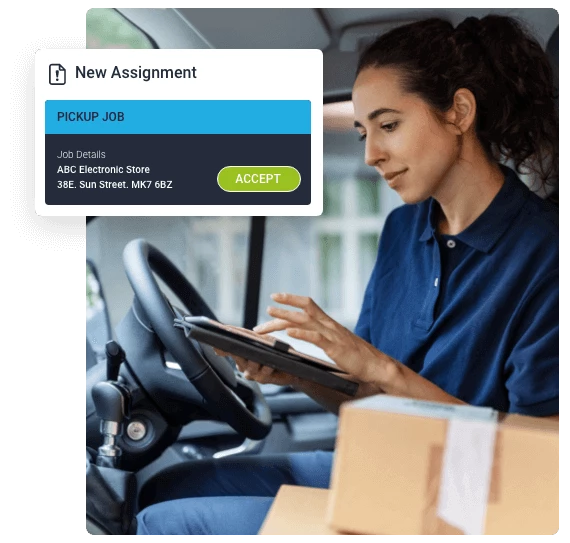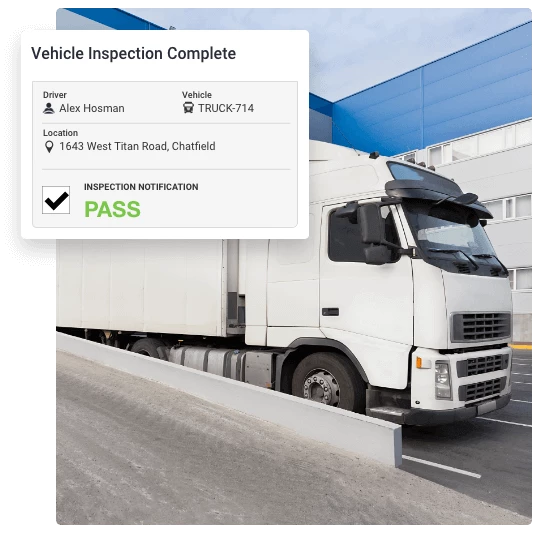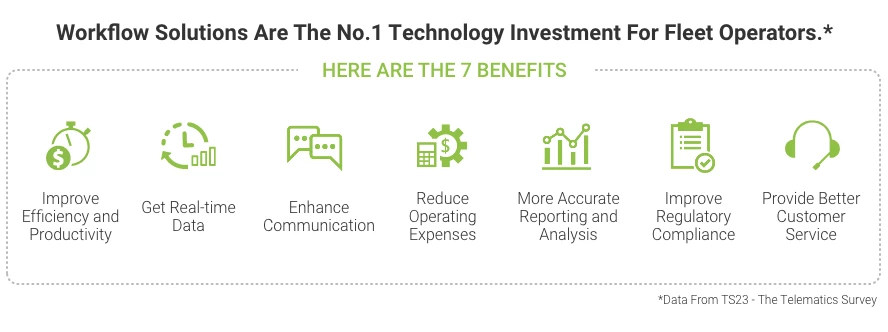Key Takeaways
Workflows improve the efficiency of any business by streamlining operations and ensuring consistency of processes, but what are workflows and how do they relate to fleet management operations?
This guide covers the critical role of workflows, everyday use cases, and the transformative benefits of digitizing these processes. Here's how to make every piece of your business more timely, coordinated and efficient.
Table of Contents
- What are Workflows?
- Fleet Management: A World Governed by Workflows
- Common Fleet Management Workflows
- Benefits of Digitizing Workflows in Fleet Management
- Importance of Seamless Workflow Integrations
What Are Workflows?
Workflows are a series of tasks or processes that must be completed sequentially to achieve a specific outcome.
You can think of workflows as building blocks designed to simplify complex operations into more manageable pieces. These processes are essential for maintaining organization and efficiency across an entire company. They play a crucial role in large operations with many moving parts and in industries where precision and timing are essential.
Fleet Management: A World Governed by Workflows
Fleet managers meticulously plan efficient fleet management operations systems. Every vehicle movement, from the initial dispatch to the final destination, follows a predefined series of tasks. This choreography is vital for ensuring that vehicles get to their destinations on time, that drivers remain safe and compliant, and that customers are satisfied at the end of each interaction.
Workflows can dictate more than just vehicle movement, and workflow blueprints aren't one-size-fits-all. The complexity and nuance of fleet operations often necessitate tailored workflows that cater to an organization's unique requirements and challenges. Effective workflows pinpoint potential bottlenecks, create redundancies where necessary and ensure a smooth transition from one task to the next. These processes ensure fleets can provide reliable services, meet delivery deadlines and uphold safety standards.

Common Fleet Management Workflows
Managing a fleet is a complex process and requires more than just knowing where vehicles are at all times. Common workflows integral to the fleet management process include:
- Vehicle maintenance and inspection. Scheduled inspections and maintenance ensure fleet safety and efficiency, dictating periodic checks and necessary actions for detected issues.
- Route planning and optimization. These workflows analyze various factors to determine the most efficient routes while optimizing fuel use and time.
- Regulatory compliance and reporting. Compliance workflows ensure adherence to local and federal regulations, emphasizing timely reporting to avoid potential penalties.
- Communication and dispatch. These workflows establish communication protocols between drivers and dispatchers, ensuring timely updates and efficient reporting on job statuses.
- Fuel management. Monitoring fuel consumption patterns and strategies like bulk purchasing ensure economic fueling and cost savings.
- Driver training. These workflows include initial and ongoing education and training for drivers on skills, safety and regulations.
- Driver dispatch and run sheets. These workflows deal with driver assignments and scheduling for routes or jobs with outlines on the details of each task.
It's important to note that these are examples that cover a variety of fleet types. However, depending on a fleet's specific nature and needs, there will likely be many other essential workflows that ensure efficient day-to-day operations.

Benefits of Digitizing Workflows in Fleet Management
Relying on traditional pen-and-paper methods or disjointed software solutions can hinder a business's potential, and slow adoption can lead to a loss of competitive advantage. Alternatively, embracing digital solutions offers numerous advantages that can supercharge your fleet operations and give you a competitive edge in your industry.
- Improve efficiency and productivity. Digital workflow software helps streamline operations. Traditional methods, like paperwork and manual data entry, can lead to errors and inefficiencies. By automating these processes, tasks are completed faster and with fewer errors. These improvements ultimately save time and resources.
- Get real-time data. Digitizing workflows provides managers with real-time data access. These insights allow them to immediately make informed decisions, like dispatching the closest driver for a job or adjusting schedules to meet changing delivery demands.
- Enhance communications. Digital platforms foster better communication between the office team, drivers and customers. Collating all information on the same platform reduces the chances of miscommunication, ensuring everyone is on the same page.
- Reduce operating expenses. With digital workflows, there's a significant reduction in paper use, manual labor and other resource-draining activities. Stakeholders can then redirect savings to areas that drive growth and profitability.
- More accurate reporting and analysis. Digital workflows allow for the collection and analysis of vast amounts of data. This analytical capability enables fleet managers to identify patterns, predict trends and make proactive decisions that optimize fleet activity.
- Improve regulatory compliance. Digitized workflows come with built-in mechanisms that ensure compliance with local and federal regulations. Improved compliance not only keeps operations running smoothly but also helps in avoiding costly penalties.
- Provide better customer service. A smooth and efficient operation leads to better service delivery. With digitization, customers get timely updates, accurate ETAs and swift resolutions to their concerns, improving customer satisfaction and loyalty.
It's important to remember that as markets and customer expectations evolve, so does the need to digitize the fleet management process. While many of these benefits are advantages today, the adoption of workflow solutions will increase and soon become the industry standard.

The Importance of Seamless Workflow Integrations
Transitioning to digital fleet management brings a significant advantage in the form of seamless workflow integration. This capability allows workflow software to integrate effortlessly with other digital tools and platforms, offering fleet managers a comprehensive view of their operations. Integration centralizes operational data, makes tracking performance metrics and compliance more manageable, and streamlines decision-making by consolidating functions across various systems.
For example, a change in vehicle status can trigger immediate updates in the dispatch system, the customer service interface and the driver mobile apps - all simultaneously. This real-time data sharing enhances communication between drivers, dispatchers, and back-office staff, enabling quick responses to changes or emergencies.
Beyond improving efficiency, an integrated system minimizes errors from manual data transfers. More accurate data leads to more reliable reporting and analytics, helping to improve decision making.
Optimize Your Fleet Management Operations with TN360
TN360 brings the power of digital workflows right to your fingertips. With the TN360 mobile apps, fleet operations are more than automated—they're optimized. Our state-of-the-art fleet management software provides the tools to digitize your workflows and offers comprehensive features that take your fleet operations to the next level.
With TN360 you can streamline your operation, reduce costs, enhance efficiency and simplify compliance. Build a custom solution for your business in minutes using our online tool, or contact us today for more information.

